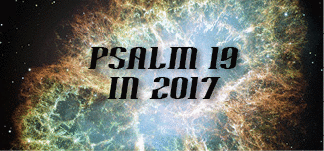

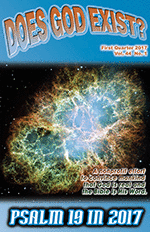
When I began my university training in earth science and astronomy in 1955, our view of the cosmos and what you could see in the night sky was very limited. As we looked through our telescopes, we could see eight other planets and a handful of moons that were orbiting those planets. We also knew that there were other fuzzy objects that were clearly more distant from Earth than our own solar system. Over the years there had been many observations made by astronomers that stretched our understanding of the size of the cosmos. We knew that in 1054 Chinese astronomers without telescopes had watched a star explode. Today, we can use the Hubble Space Telescope to see the Crab Nebula which is the residue from that explosion (cover picture and above). As our telescopes improved, we became aware that the fuzzy objects were actually other galaxies, massive universes of billions of stars spinning around a core.
With the constant growth of knowledge came mysteries. The galaxies were spinning so fast that no force known to science could keep them from flying apart. The measurements of the speed of the galaxies as they went through space showed that the galaxies in front of us are moving faster than we are, and the galaxies behind us are moving slower than we are. We now know that we are in an expanding universe. Our simple tools of physics like the Doppler effect helped us understand these motions, and simple mathematical tools like triangulation helped us understand the distances involved.
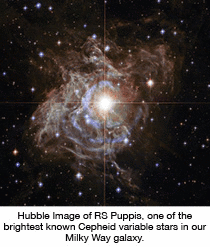
As astronomers studied stars called Cepheid variable stars in our part of space, they realized that the changes in brightness of these stars were a function of how fast they flickered. That meant astronomers knew exactly how bright the star was, and since physics tells us that how bright a light source is divided by how far away it is (squared) will give you the brightness you will actually see. The physics equation is E=I/x2 where E is the brightness we measure, I is the known intensity of the light, and X is how far away the light is from us. We now have the ability to measure distance on a galactic scale. Recently astronomers discovered that type 1a supernovae always have the same brightness, so another tool has been discovered to make measurements in space.
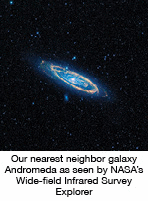
All of this has led to new understandings in the twenty-first century. Having telescopes in Earth orbit above the atmosphere's distortion, and huge telescopes that can gather very faint light intensities has radically changed our understandings. We now know that what holds galaxies together is a form of matter/energy called dark matter that we did not know existed. We have learned that the galaxies are speeding up in their expansion, not slowing down as one would expect. Dark energy is applying a previously unknown repulsive force to objects in the cosmos. We have learned that the solar system includes many planets beyond our traditional nine planets, and we have discovered that most stars have planetary systems orbiting them. As we gather light from distant light sources, we have become aware that our galaxy is just one of millions or perhaps billions of galaxies.
In addition to the advances in astronomy, which deal with the very large, we have made incredible advances in understanding the very small. The science that allows us to do this is quantum mechanics. We are beginning to understand what it takes to make an electric charge and mass, meaning that electrons and protons are end products of a whole new science that has different rules and laws that govern how these things are produced.
In spite of our growth in knowledge and our accumulation of amazing facts, our ignorance is profound. As Dr. Bob Berman recently wrote in Astronomy magazine (August 2016, page 6) “Our ignorance of the overall cosmos is profound — including basics like what it is, how it started, whether it is infinite, its destiny, what it’s composed of, and the relationship between the living and the nonliving.”
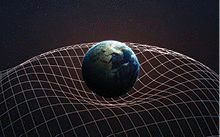
For the Christian, all of these new discoveries are strong supports for belief in God and for the integrity of the biblical record. Genesis 1:1 indicates that God created everything above us. The Hebrew word bara translated “created” in your Bible refers to a process only God can do. It is used with the Hebrew word shamayim which is translated “heaven” in your Bible and refers to everything above us — the galaxies, nebulae, extra solar planets, asteroids, meteoroids, comets, as well as the Sun, Moon, and black holes. Bara is not used in verses 14 – 19 where the chronometers of time are established. There the word is asah which tells us natural processes shaped and molded the universe we live in to make it hospitable for humans. As we explore dark matter, we see how God used a strange form of matter as the glue to hold galaxies together. As we learn about gravity waves, we see a complex tool God used to shape all matter and mold the Earth so that we could live on it. New measurements of the size of the cosmos have told us there are 1.2 million galaxies in a volume of 650 cubic billion light years (Astronomy, November 2016, page 10) expanding our understanding of God's power and magnitude.
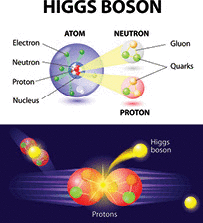
No one should see all of these new discoveries as a threat to belief in God or to the credibility of the Bible as God's Word. In reality, each new discovery helps us understand the complexity of creation more fully. The Higgs Boson, gravity waves, and all of the laws of quantum mechanics speak to the difficulty of creating matter in a stable form, and of designing an atom with the creation of electric charge and the use of quarks and neutrinos to manufacture stable matter in all of its forms. We are just beginning to understand how simultaneity may have contributed to the formation of solar systems and molecular structures. Some of these discoveries have tantalizing suggestions about how some of the miracles in the Bible took place, and even such simple things as how God can hear everyone's prayer at once. This does not make the miracles non-miracles but shows God's capacity to control things at a level beyond our ability to fully understand.

One of Einstein's best quotes is “God is subtle, but He is not malicious.” 1 For many of us in science, discovering something new is simply a wonderment at what God has done. Einstein talks about the amazing complexity of God’s creation. “Religious feeling takes the form of rapturous amazement at the harmony of natural law, which reveals an intelligence of such superiority that, compared with it, all the thinking and acting of human beings is insignificant.” 2 Dr. Henry Schaeffer gives a similar view when he speaks of his own scientific discoveries, “The significance and joy in my science comes in those occasional moments of discovering something new and saying to myself, ‘So that's how God did it.’ My goal is to understand a little corner of God’s plan.” 3 Isaac Newton said, “I do not know what I may appear to the world, but to myself I seem to have been only like a boy playing on the seashore, and diverting myself in now and then finding a smoother pebble or a prettier shell than ordinary, whilst the great ocean of truth lay all undiscovered before me.” 4 Dr. Frank Baxter gave another view saying, “The more we know of the creation, the 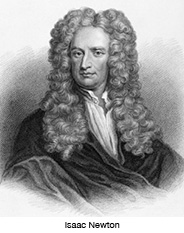 closer we get to the Creator.” 5 We are so fortunate to live at a time when knowledge is exploding, and our understandings are so much better than in the past. Understanding what God has done and maybe even a little about how he did it, should not create anxiety within us. It should fill us with gratitude and wonderment at what we are and what we understand as we stare into the heavens and look into the basic materials of which we are made. This should also raise for us the question posed by the psalmist David, “When I consider your heavens, the work of your fingers, the moon and the stars, which you have set in place, what is mankind that you are mindful of them, and human beings that you care for them?” (Psalm 8:3 – 4).
closer we get to the Creator.” 5 We are so fortunate to live at a time when knowledge is exploding, and our understandings are so much better than in the past. Understanding what God has done and maybe even a little about how he did it, should not create anxiety within us. It should fill us with gratitude and wonderment at what we are and what we understand as we stare into the heavens and look into the basic materials of which we are made. This should also raise for us the question posed by the psalmist David, “When I consider your heavens, the work of your fingers, the moon and the stars, which you have set in place, what is mankind that you are mindful of them, and human beings that you care for them?” (Psalm 8:3 – 4).
- https://en.wikiquote.org/wiki/Albert_Einstein
- http://www.stephenjaygould.org/ctrl/einstein_religion.html
- Henry F. Schaefer, Science and Conflicts: Conflict or Coherence? The Apollos Trust, © 2003,
page 42.- https://en.wikiquote.org/wiki/Isaac_Newton
- “The Strange Case of the Cosmic Rays,” Bell Laboratories, video number 3, 1957
Picture credits:
Top photo and cover photo: NASA, ESA, J. Hester, A. Loll (ASU)
https://commons.wikimedia.org/wiki/File:Heic1323a_-1243686232.jpg
NASA/JPL-Caltech/UCLA
© Forplayday. Image from BigStockPhoto.com
© designua. Images from BigStockPhoto.com
© Candyman. Image from BigStockPhoto.com
© Candyman. Image from BigStockPhoto.com
